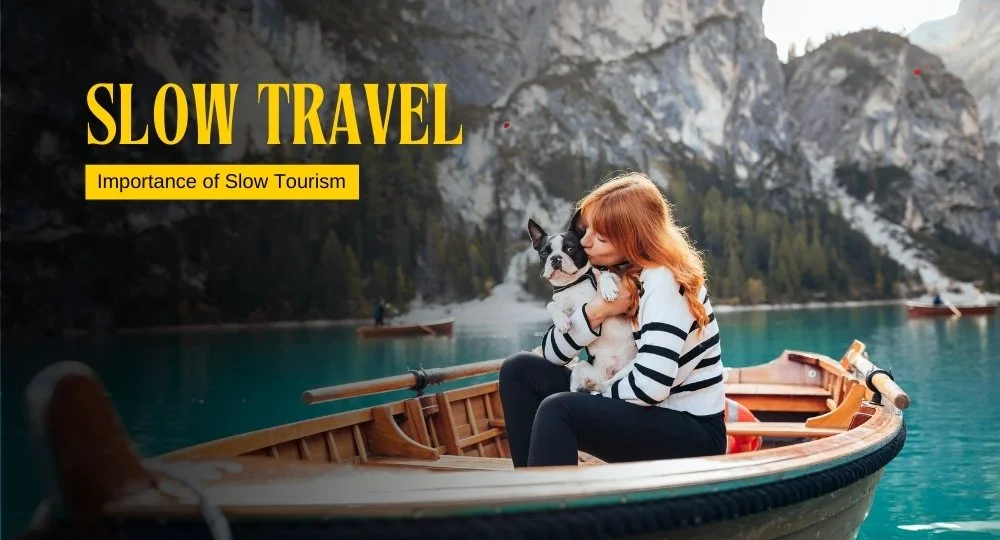One recent travel trend that has gained more popularity is slow tourism. Although this term is not new, it’s working as the antidote for negative aspects of tourism trends. Slow tourism with the enjoyment of travelling and exploration is also focused on sustainability, promoting the local culture and experiencing the aura of places to the fullest. We can see many travel enthusiasts started slow travel and it changed their whole experience. After the covid-19 slow travel started gaining popularity and as per the reports it will gain more popularity in the future. Let us know more about slow tourism and how to practice it.
Meaning of Slow Travel
As the name suggests slow travel is a form of tourism which encourages travellers to take their time and experience the destination deeply. It is the opposite of mass tourism in which traveller wants to cover a maximum number of tourist places in a short period. It emphasises knowing about the local culture, history, and belief system to get the most out of it. Most travellers make an itinerary follow it and cover all the places in one go which is kind of a headache and can lead to disappointment. Slow travel will make you fall in love with the places as you know about the beauty of the place with their tradition.
Famous Places of Slow Travel in India
| Place Name | Days Required |
| Spiti Valley | 8-10 Days |
| Shekhawati Region | 6-9 Days |
| Varanasi | 7-10 Days |
| Alleppey | 5-7 Days |
| Ziro Valley | 7-10 Days |
| Khimsar Village | 4-5 Days |
| Vrindavan | 7-9 Days |
| Hampi | 5-7 Days |
| Darjeeling | 7-9 Days |
| Ranthambhore & Jaipur | 6-9 Days |
| Ujjain | 4-5 Days |
| Dwarka | 4-5 Days |
| Nashik | 3-5 Days |
| Wayanad | 7-9 Days |
Also Read – Jaipur vs Udaipur | Sustainable Tourism in India
Why One Should Do Slow Tourism?
- If a traveller wants to know about the culture and lifestyle and wants to engage with them then slow tourism is required. Rather than rushing through tourist spots, you can experience everyday life and form meaningful connections with the local community.
- Slow tourism decreases the stress and allows you to relax, admire, recall and mediate during the travel. From writing books in the mountains to chilling in cafes, from admiring the beauty of forts to celebrating the local culture.
- If you are someone who loves the enjoy the authentic experience then slow tourism is for you.
- Slow tourism allows you to travel to offbeat destinations which are only known by the locals.
- If you are someone who loves to travel but dont want to ruin the environment then slow tourism is for you.
Benefits of Slow Traveling
Cultural Benefits
Slow travelling encourages a person to spend longer periods at a location. If travellers spend more time at a place engaging in the local things then they will write about the place and their culture and share photos and videos which promote the local culture. It prevents the situation where a location becomes a popular destination and things have modernised near them by killing the local culture for commercials.
Environmental Benefits
One of the major concerns with travelling is that it will increase the environmental concerns. Slow tourism aims to reduce the travelling frequency which decreases the carbon footprint. It also means spending more time enjoying each activity, which can reduce carbon emissions associated with local travel.
Sustainability
Slow tourism promotes sustainability by encouraging longer stays and a reduced need for constant transportation. It aligns with responsible travel practices that aim to protect natural and cultural resources for future generations.
Stress Buster
Travelling slowly reduces the stress often associated with hectic travel itineraries. It allows for moments of reflection, relaxation, and mindfulness. Whether it’s enjoying a quiet café, a long hike, or simply soaking in the scenery, slow tourism offers mental and emotional rejuvenation.
Also Know – Local culture of Rajasthan | Dark Tourism
How to Practice Slow Travelling?
- The first step is to select the destination wisely instead of seeing everything in place pick a specific destination and a long time there.
- Explore the lesser-known area of destinations.
- Instead of travelling in cabs use public transport or bicycle so you can soak the environment.
- Dont rush to go to another location just admire one place and then move to the next place.
- Book longer stays and preferably the homestays.
- Initiate talks with the local people and learn more about their culture.
- Celebrate the local festivals, and events and try to be like them.
- Focus on quality over quantity.
- Spend time walking, hiking, or cycling to connect more deeply with the environment.
- Eat at local restaurants, shop at farmers’ markets, and use services provided by local businesses.
- Always practice environmentally friendly travel and reduce waste.
- Write about your experiences, thoughts, and reflections to deepen your connection with the place.
- Focus on capturing moments and stories rather than just popular sights.
Where did Slow tourism come from?
Well, there is no exact time when the slow tourism started but it is connected to the slow food movement of the 1980s. Carlo Petrini with a group of activists started the slow food movement against the opening of Macdonalds. It started to defend religious food, traditional, gastronomic pleasure and a slow pace of life. Further, it is associated with sustainability and slow tourism comes into play. Slow tourism is now gaining popularity like never before. This industry is increasing with 10% growth every year. Travellers are more interested in staying at a place that knows the culture fully instead of covering multiple locations.


